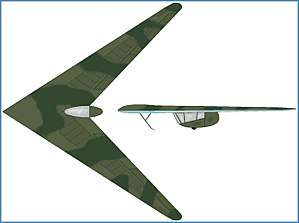Horten H.XIII
The Horten H.XIII was an experimental flying wing aircraft designed by the Horten brothers during World War II.
| H.XIII | |
|---|---|
 | |
| Role | High performance sailplane |
| National origin | Germany |
| Manufacturer | Horten |
| Designer | Walter and Reimar Horten |
| First flight | 27 November 1944 |
| Number built | 1 |
Design
The H.XIIIa was an unpowered glider with wings swept backwards at 60°. It was intended as a technology demonstrator for a supersonic fighter jet capable of traveling beyond Mach 1 (H.XIIIb).
Specifications (H.XIIIa)
Data from Nurflügel[1]
General characteristics
- Crew: 1
- Length: 10 m (32 ft 10 in) nose to wing-tips
- Wingspan: 12 m (39 ft 4 in)
- Wing area: 36 m2 (390 sq ft)
- Aspect ratio: 4.0
- Empty weight: 250 kg (551 lb)
- Max takeoff weight: 330 kg (728 lb)
Performance
- Stall speed: 44 km/h (27 mph, 24 kn)
- Never exceed speed: 180 km/h (110 mph, 97 kn)
- Take-off speed: 44 km/h (27 mph; 24 kn)
- Landing speed: 44 km/h (27 mph; 24 kn)
- Maximum glide ratio: 16:1 at 80 km/h (50 mph; 43 kn) and 9.2 kg/m2 (1.9 lb/sq ft)
- Rate of sink: 1.1 m/s (220 ft/min) at 60 km/h (37 mph; 32 kn)
- Wing loading: 9.2 kg/m2 (1.9 lb/sq ft)
References
| Wikimedia Commons has media related to Horten H.XIII. |
- Horten, Reimar; Peter F. Selinger (1985). Nurflügel (in German) (1st ed.). Graz: H. Wieshaupt Verlag. pp. 158–162. ISBN 978-3-900310-09-7.
Further reading
- Rose, Bill (2010). Flying wings and tailless aircraft. Hinckley: Midland. pp. 50–51. ISBN 978-1-85780-320-4.
This article is issued from Wikipedia. The text is licensed under Creative Commons - Attribution - Sharealike. Additional terms may apply for the media files.